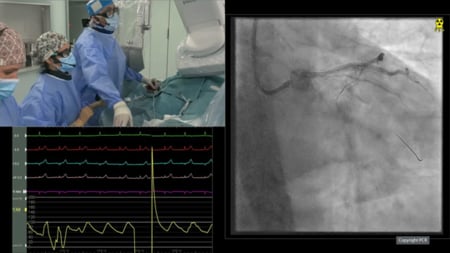EXpansion of stents after Intravascular lithoTripsy versus conventional predilatation in CALCified coronary arteries: the EXIT-CALC – a prospective, randomized study
Reported from TCT 2022
Pierre Deharo and Michele Pighi share with us their views on the EXIT-CALC study presented by Thomas Oomens at TCT 2022.
Why this study? – the rationale/objective
The management of coronary calcium is a key aspect that interventional operators must face on a daily basis in routine catheterization laboratory activity, while performing percutaneous coronary interventions.
Heavily calcified coronary lesions still represent a challenge for interventional cardiology, and are associated with lower procedural success rates (e.g., failure to cross or deploy the stent), higher risk of complications (e.g., dissections, perforations), and long-term stent failure (e.g., stent thrombosis and in-stent restenosis), of which stent under-expansion represent a powerful predictor, according to authors.
Consequently, calcified coronary lesions are a predictor of a worse clinical outcome, associated with higher mortality, major adverse cardiovascular events (MACE), and target vessel failure.
Coronary calcification can be diagnosed by coronary angiography; however, such a technique is limited by low sensitivity and qualitative-only grading of calcium.
On the contrary, intracoronary imaging by optical coherence tomography (OCT), thanks to its very high resolution, allows for a better characterization, such as the extent and depth of calcium in lesions at risk for stent under-expansion.
Dedicated devices should be used for adequate lesion preparation in this challenging contest (e.g., atherectomy, scoring/cutting balloons). However, such techniques are characterized by an increased burden involve of complications while lacking a clear benefit in the randomized trials which have been carried out so far.
In recent years a novel technique called intravascular lithotripsy (IVL) has emerged as a valuable alternative to treat calcium, involving both the superficial and deep layers of the vessel wall. Nevertheless, so far, the safety and efficacy of this device have been reported in single-arm studies.
The present study sought to evaluate stent expansion after IVL versus balloon angioplasty prior to stenting in a predefined subset of severely calcified lesions.
How was it executed - the methodology?
The EXIT-CALC is a prospective, randomized study which aimed to evaluate stent expansion after IVL versus balloon angioplasty prior to stenting in a predefined subset of severely calcified lesions with systematic evaluation by OCT.
Lesions were eligible for enrolment when the lesion OCT-derived calcium score was 4 (taking into account the maximum calcium angle, thickness and length. Figure 1).

Figure 1. OCT-derived calcium score - Adapted from A. Fujino, et al. Eurointervention 2018
What is the main result?
A total of 40 patients have been randomized (19 IVL versus 21 treated by conventional strategies), with a mean number of stents of 1.7 ± 0.6.
Post dilatation was performed with non-compliant balloons in 100 % of the patients in the conventional arm, and 94.7 % of IVL arm.
Stent expansion did not differ between the 2 groups (83.9 % ± 10.3 % in the IVL arm vs 82.2 % ± 11 % in the conventional arm), with an overall 100 % procedural success and no periprocedural complications or MACE reported up to 30 days post-procedure.
The authors concluded that no significant differences in stent expansion were observed after plaque modification by means of intravascular lithotripsy as compared with balloon angioplasty in severely calcified lesions with the highest probability of stent under-expansion.
Furthermore, they stressed that OCT was systematically used and aggressive predilatation was encouraged.
Summary
- Calcified coronary lesions represent a challenging scenario for percutaneous interventions with lower procedural, increased complications, and higher risk of long-term stent failure.
- OCT represents a useful tool enabling better characterization of calcified plaque.
- Intravascular lithotripsy (IVL) represents a less aggressive and possibly safe alternative to conventional strategies (atherectomy and soring/cutting balloon angioplasty)
- In the present small study (40 pts), the investigators did not find significant differences in terms of stent expansion between the two strategies. However, the impact of the IVL strategy on the long-term outcomes warrants further larger studies.
Authors







No comments yet!